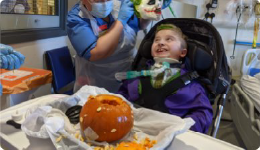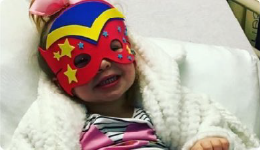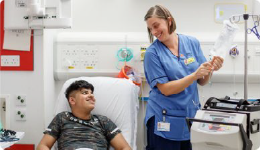Click here for printable versions of this leaflet in:
Linezolid, information for parents and carers

This advice is intended for parents/carers taking their child home after consulting a doctor. Your doctor may recommend different treatments depending on your child's condition.
- Tablets: 600mg
- Liquid medicine: 100 mg in 5 mL
This will depend on the age of your child.
- If prescribed twice each day You should give your child linezolid in the morning and in the evening. Ideally these times are 10-12 hours apart. For example, 8am and 8pm.
- If prescribed three times a day You should give your child linezolid in the morning, early afternoon and at bedtime. Ideally, these times are at least 6 hours apart. For example, 8am, 2pm and 8pm.
Try to give the medicine at about the same times each day so that this becomes part of your child’s daily routine, which will help you to remember.
Your doctor and pharmacist will work out the amount of linezolid (the dose) that is right for your child. The dose will be shown on the medicine label.
It is important that you follow these instructions about how much to give your child.
You can give linezolid with or without food.
Tablets - your child should swallow these with a glass of water, milk or juice. Or you can crush the tablets and put this in water before giving them to your child. Your child should not chew the tablets.
Liquid medicine - Shake the medicine well. Measure out the right amount using an oral syringe or a medicine spoon. You can get these from your pharmacist. Do not use a kitchen teaspoon as it will not give the right amount.
- If your child is sick less than 30 minutes after having a dose of linezolid, give them the same dose
- If your child is sick more than 30 minutes after having a dose of linezolid, you do not need to give them another dose. Wait until the next scheduled dose. Never give a double dose where a dose has been missed. If your child is sick again - get advice from a doctor, nurse or pharmacist who will guide you on what to do.
If you usually give it twice a day: If you remember up to 4 hours after you should have given a dose, give your child the missed dose. For example, if you usually give a dose at about 7 am, you can give the missed dose at any time up to 11 am. If you remember after that time, do not give the missed dose. Just give the next dose as usual.
If you usually give it three times a day: Do not give the missed dose. Just give the next dose as usual.
If you give an extra dose by mistake or if you think you may have given your child too much linezolid, contact your doctor or NHS 24 on ![]() 111. Have the medicine container or packet with you if you telephone for advice.
111. Have the medicine container or packet with you if you telephone for advice.
We use medicines to make our children better, but sometimes they have other effects that we don’t want (side-effects). Please see the leaflet that comes with the medicine for a full list of side effects. If you have any concerns, please discuss them with your GP or hospital doctor or telephone NHS 24 on ![]() 111 for advice.
111 for advice.
Side-effects you must do something about
If your child is short of breath or is wheezing, or their face lips or tongue start to swell, or they develop a rash, they may be allergic to linezolid. Take your child to hospital or call an ambulance straight away.
Important - If your child develops any of the following symptoms whilst taking linezolid contact your hospital doctor immediately or go to your nearest Accident and Emergency department:
- Severe headache
- Unexplained bruising or bleeding
- Blurred vision or other problems with eyesight
- Tingling or numbness in hands or feet
- Severe or persistent diarrhoea
- Recurrent nausea and vomiting, abdominal pain or increased breathing rate
If your child is prescribed linezolid for more than a week, we will ask you to return to the hospital for weekly blood tests. This is to help us monitor for side effects and keep your child safe.
If your child is prescribed linezolid for longer than 28 days your doctor will also arrange to have your child’s eyesight monitored. We may monitor younger children’s eyesight even if they are taking it for less than 28 days.
Your doctor will decide how long you child needs to take linezolid. Do not stop giving your child linezolid until your doctor tells you to stop. If your child stops it too soon, it may cause the infection to come back.
Eating certain foods can increase your child’s blood pressure when they are taking medicine. They should avoid the following types of foods:
- Any food that is not fresh, over ripe or beyond the expiry date
- Mature or aged cheese, sour cream and yoghurt
- Liver, kidney, pickled herring, anchovies, caviar, wild game g. venison, rabbit
- Fermented or air-dried meats, such as salami, pepperoni and Lebanon bologna
- Yeast extracts, for example Bovril, Oxo or Marmite
- Fermented soya bean products, for example, soy sauce
- More than 500g dark chocolate
- Protein diet supplements
- Broad beans, peanuts, canned figs, dried fruits (raisins, prunes)
- Over ripe fruits especially bananas and avocados
If your child develops a throbbing headache after eating or drinking whilst taking linezolid tell your doctor or pharmacist immediately.
You can give your child medicines that contain paracetamol or ibuprofen, unless your doctor has told you not to.
Linezolid should not be taken with some medicines that your child may get on prescription. Tell your doctor and pharmacist about any other medicines your child is taking before giving linezolid.
Check with your doctor or pharmacist before giving any other medicines to your child. This includes herbal or alternative medicines, decongestants and flu remedies.
- Keep this medicine in a cupboard away from heat and direct sunlight
- Keep out of reach of children
- Keep the medicine in the container it came
Your child’s doctor, pharmacist or nurse will be able to give you more information about linezolid and about other medicines used to treat infections.
You can also get useful information from:
NHS 24:
Telephone: ![]() 111
111
Website: www.nhs24.scot










